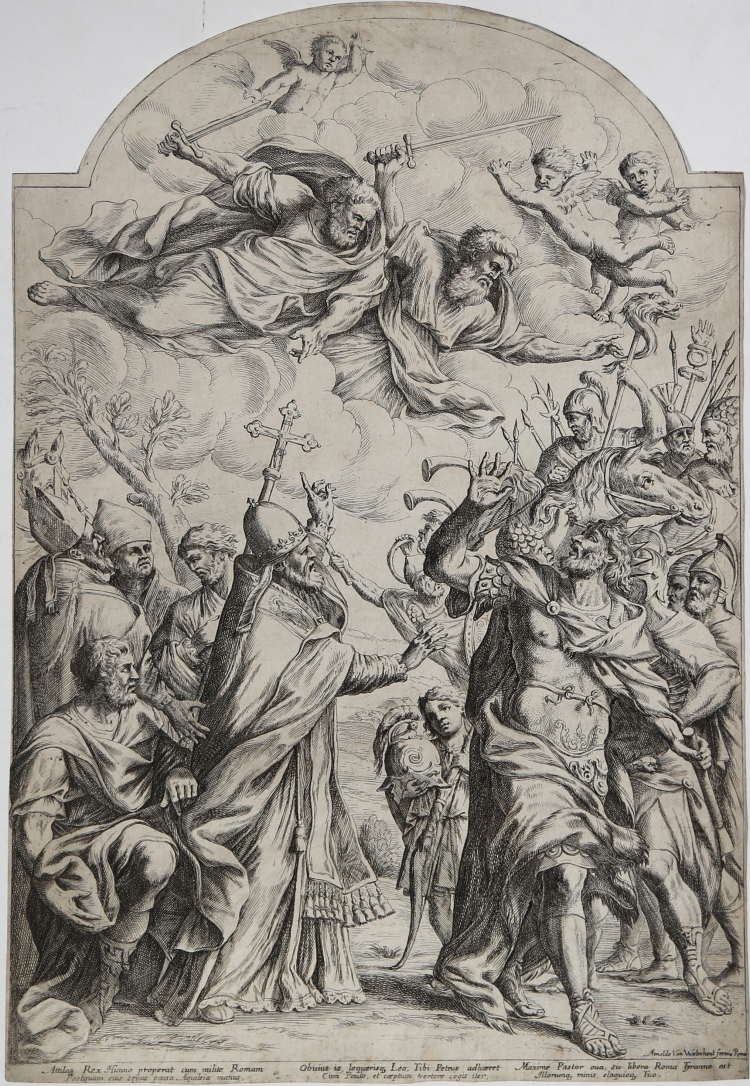




| Reference: | S44289 |
| Author | Giuseppe Maria MITELLI |
| Year: | 1660 ca. |
| Measures: | 320 x 475 mm |



| Reference: | S44289 |
| Author | Giuseppe Maria MITELLI |
| Year: | 1660 ca. |
| Measures: | 320 x 475 mm |
Pope Leo repulses Attila from the gates of Rome, pointing to Sts Peter and Paul who fly to the rescue with swords drawn.
Etching after Alessandro Algardi, lettered Attila Rex Hunno properat cum milite Romam / Postquam eius seuas passa Aquileia manus, // obvius is, loquerisq Leo Tibi Petrus adhaeret / Cum Paulo, et caeptu, vertere cogis ter, // Maxime Pastor ava, sic Libera Roma Tyranno est / Illorumq minis, eloquioq tuo.
Example of the second state with the imprint of Arnold van Westerhout (1651–1725).
This print is after a bas-relief by Alessandro Algardi in St. Peter's in the Vatican.
Giuseppe Maria Mitelli (Bologna 1634 - 1718) was the son of Agostino, a well-known painter and engraver; according to his brother Giovanni in his Vita et opere di Agostino Mitelli, he trained with a number of important artists, studying with Simone Cantarini, Francesco Albani, Guercino and Flaminio Torri, among others. Of his pictorial activity, far from limited according to ancient evidence, however, a very meager corpus remains, consisting of only a few units. He devoted his greatest efforts to the art of engraving, initiated in all probability by his father, leaving behind some 600 prints executed largely in etching. In 1660 Mitelli published the Arti per via, a series of 40 etchings derived from the inventions of Annibale Carracci, translated into print in 1646 into 80 plates by Simone Guillain. With the enterprise, edited by the Roman Giovanni Giacomo De Rossi, Mitelli inaugurated a flourishing production of images with popular themes, which became something of a trademark of the Bolognese engraver.
Bibliografia
Bertarelli 1940 / Le Incisioni di Giuseppe Maria Mitelli, catalogo critico, n. 34 II; Bartsch / Le Peintre graveur (XIX.280.28).
Giuseppe Maria MITELLI (Bologna 1634 – 1718)
|
Giuseppe Maria Mitelli (Bologna 1634 - 1718) was the son of Agostino, a well-known painter and engraver; according to his brother Giovanni in his Vita et opere di Agostino Mitelli, he trained with a number of important artists, studying with Simone Cantarini, Francesco Albani, Guercino and Flaminio Torri, among others. Of his pictorial activity, far from limited according to ancient evidence, however, a very meager corpus remains, consisting of only a few units. He devoted his greatest efforts to the art of engraving, initiated in all probability by his father, leaving behind some 600 prints executed largely in etching. In 1660 Mitelli published the Arti per via, a series of 40 etchings derived from the inventions of Annibale Carracci, translated into print in 1646 into 80 plates by Simone Guillain. With the enterprise, edited by the Roman Giovanni Giacomo De Rossi, Mitelli inaugurated a flourishing production of images with popular themes, which became something of a trademark of the Bolognese engraver.
|
Giuseppe Maria MITELLI (Bologna 1634 – 1718)
|
Giuseppe Maria Mitelli (Bologna 1634 - 1718) was the son of Agostino, a well-known painter and engraver; according to his brother Giovanni in his Vita et opere di Agostino Mitelli, he trained with a number of important artists, studying with Simone Cantarini, Francesco Albani, Guercino and Flaminio Torri, among others. Of his pictorial activity, far from limited according to ancient evidence, however, a very meager corpus remains, consisting of only a few units. He devoted his greatest efforts to the art of engraving, initiated in all probability by his father, leaving behind some 600 prints executed largely in etching. In 1660 Mitelli published the Arti per via, a series of 40 etchings derived from the inventions of Annibale Carracci, translated into print in 1646 into 80 plates by Simone Guillain. With the enterprise, edited by the Roman Giovanni Giacomo De Rossi, Mitelli inaugurated a flourishing production of images with popular themes, which became something of a trademark of the Bolognese engraver.
|